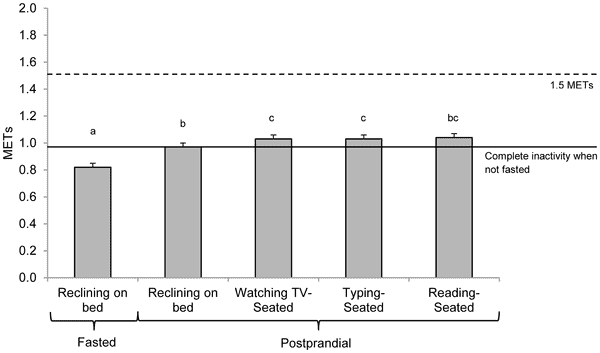Western society is becoming ever sedentary, as more and more jobs have transitioned to the office and technology offers people all kinds of comfortable reasons not to leave their homes. It’s well documented how a sedentary lifestyle can affect health, exposing the body to a slew of diseases, still a careful assessment of sedentary energy expenditure are remarkably fundamental to many researchers. Yes, your burn calories even when sitting on your butt for hours. Not too many though, as you’ll find out.
A team of researchers Pennington Biomedical Research Center in Baton Rouge, Louisiana sought to find the exact energy expenditures of sedentary “activities”, including reclining, watching television, reading or typing at the computer. With this in mind, twenty-five African-American individuals (10 men, 15 women) were selected to participate in the study to spend eight hours in a metabolic chamber – a room that monitors respiration levels to determine energy expenditures.

Part of the study, the participants were fed breakfast and then engaged in the following activities for 30 minutes at a time: reclining/resting, watching TV, sitting at a desk, reading a book (sedentary activities), walking on a treadmill at a pace of 1.5 miles per hour (light intensity physical activity), and walking at 3 miles per hour on the treadmill (moderate intensity physical activity). After lunch was served, all of the previous activities were repeated. This is because energy expenditure is different at various times of the day and because the percentage of time spent sitting is greatest during the workday in the modern chair-dominated office environments, quantifying sitting energy expenditure should be done at multiple times.
Wait a second… is this a study that measures laziness? More or less, yes, without any intention of discrediting the authors or the actual scope of the study, which I earnestly believe holds value. I just wish I could sign up.
Oh, well. Eventually, the researchers found subjects burned about 1 calorie per kilogram of body weight per hour while reclining, 1.08 sitting while reading or watching TV, and 1.11 while typing at a computer. It’s important to note that sitting, instead of lying down, burned on average 7 more calories per hour. For an overweight society, this is something that all of us might want to consider. This or go out for a run, then you can lie down as much as you like.
Findings were reported in the journal PLOS ONE.






